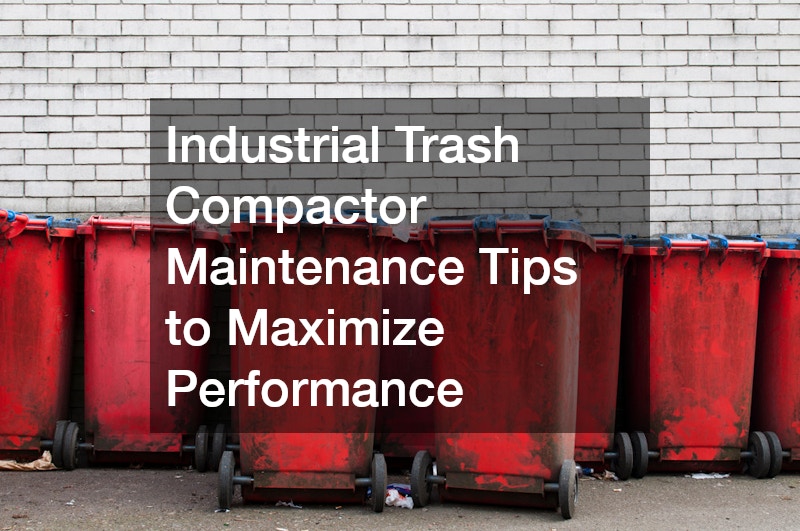Industrial trash compactors are integral to businesses managing substantial waste, enhancing efficiency, and reducing environmental impact. These powerful machines require regular maintenance to operate at peak performance, extending their lifespan and ensuring safety and reliability. Many facilities often overlook maintenance measures, which can lead to costly repairs and downtime. By understanding and implementing essential maintenance practices, companies can maximize the operational capabilities of their industrial trash compactors.
This article delves into practical tips and advice, aiming to assist businesses in maintaining their compactors effectively.
Regular Cleaning
Maintaining cleanliness is crucial for industrial trash compactor performance and longevity. Accumulated waste and debris can cause blockages or mechanical issues without proper cleaning. Regularly cleaning the compactor helps prevent buildup, ensuring smooth operation and reducing the risk of malfunctions. It is recommended to establish a cleaning schedule, tailoring it to the specific operational demands and volume of waste processed by the compactor. Moreover, utilizing appropriate cleaning materials ensures that the compactor’s components are not damaged during maintenance.
An effective cleaning routine involves more than just surface wiping; it requires attention to the different components of the compactor. Operators should clean accessible surfaces, including the compactor’s bin and other internal parts, to prevent build-up of harmful bacteria and unpleasant odors. Additionally, maintaining a clean working environment around the compactor is essential to avoid obstructing its operations or attracting pests. Operators should be well-trained in cleaning protocols to ensure both safety and thoroughness. Overall, a regular and comprehensive cleaning process enhances compactor efficiency and extends its service life.
Routine Inspections and Lubrication
Conducting regular inspections is a fundamental aspect of industrial trash compactor maintenance. Inspections provide an opportunity to identify minor issues before they develop into significant problems, potentially leading to costly repairs and downtime. Operators should check for signs of wear and tear, such as cracks, rust, and weakened moving parts. By scheduling frequent inspections, businesses can proactively address repairs, minimizing the likelihood of unexpected breakdowns. Such preventative maintenance strategies ultimately contribute to the compactor’s longevity and reduce overall operational costs.
Lubrication is essential for ensuring the smooth operation of moving parts within an industrial trash compactor. Failure to lubricate components like chains, bearings, and hinges can lead to increased friction, resulting in inefficient performance and excess wear. Selecting the appropriate type of lubricant is crucial, as it influences the effectiveness and longevity of the lubrication. An improper choice can lead to build-up and eventually disrupt the functionality of the compactor. Therefore, businesses should adhere to manufacturer recommendations or consult with professionals to determine the most suitable lubricants for their compactors.
Incorporating routine lubrication into maintenance schedules not only enhances performance but also prevents metal-to-metal contact, a common cause of mechanical failures. Regular lubrication reduces operational noise and vibration, contributing to a safer and more comfortable work environment. Performing lubrication aligns with preventive maintenance practices, as it provides another opportunity to inspect the compactor for potential issues. Recording lubrication schedules and inspection results is also beneficial for monitoring the health and efficiency of the compactor over time. This practice aids in making informed decisions regarding maintenance frequency and types.
Hydraulic and Electrical System Checks
The hydraulic system is central to the functionality of industrial trash compactors, necessitating thorough and regular checks. Hydraulic fluid levels should be monitored frequently, and any discrepancies or leaks addressed immediately to avoid damage. Low or unclean hydraulic fluid can significantly impair the compactor’s efficiency, slowing operations and potentially damaging components. Regular checks for hose integrity and connections are vital to prevent catastrophic failures that could result in hazardous leaks. Keeping hydraulic systems in peak condition maximizes performance and enhances the safety and reliability of the compactor.
Similarly, rigorous inspection of the electrical system is necessary to ensure the compactor operates without interruption. Key components such as wiring, switches, and sensors should be examined for wear or damage. Addressing issues promptly prevents electrical failures that can halt operations and compromise safety. Keeping the electrical system in optimal condition also ensures that safety mechanisms like emergency stops function correctly, protecting operators and machinery. Documentation and regular testing form the basis of a dependable electrical system maintenance strategy, preventing unforeseen disruptions in compactor operations.
Proper maintenance of industrial trash compactors is not just a routine task; it is an investment in efficiency, safety, and longevity. By implementing regular cleaning, lubrication, and inspections, businesses can ensure these machines operate at their best, minimizing unexpected repairs and downtime. Additionally, attention to hydraulic and electrical systems is essential in maintaining reliable and safe compactor operations. A structured maintenance plan not only prolongs the lifespan of the equipment but also contributes significantly to achieving sustained operational efficiency. Ultimately, well-maintained compactors enhance waste management strategies, thereby positively impacting the environment and business bottom lines.

